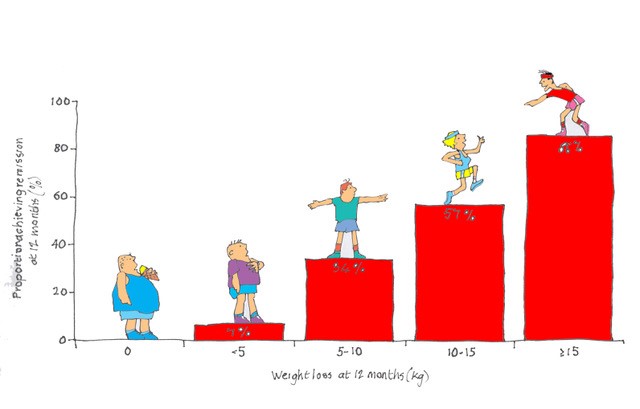EXERCISE AND THE MANAGEMENT OF DIABETES
Weight control is critical to the prevention and treatment of Type 2 Diabetes Mellitus (T2DM). It is a combination of diet and exercise which can most effectively implement this control.
Exercise in the prevention of diabetes
As discussed lat week, T2DM is caused by a mixture of over-eating and under-exercising. Although there is a genetic contribution to the risk of developing T2DM the trigger is almost always being too fat. A number of studies have confirmed this. Diet and exercise have been shown to reduce the chance of developing T2DM in susceptible people (ie obese people or those with insulin resistance) to around half the expected level. For example the latest Cochrane Review looked at 12 randomised controlled trials of diet and exercise for some 5,000 people at high risk of T2DM. It concluded that this intervention reduced the risk of T2DM with the additional benefits of reduction in weight, waist circumference and blood pressure. Comparing trials of exercise only with diet only treatment showed no difference but the combination was more effective than either on their own.
Exercise in the treatment of diabetes
Diet and exercise should be the centrepieces of any treatment for diabetes, aiming to reduce weight and thereby lessen insulin resistance. If this done quickly and effectively many patients with diabetes are cured. The most successful randomised controlled trial (RCT) of life-style management of T2DM was reported from Scotland and Newcastle in 2018. In this study, 298 obese diabetic patients received either intensive weight management or usual care. The intervention group had their medication withdrawn, were given total food replacement for 12 weeks followed by a 4 week food reintroduction phase. This was followed by a weight management phase of up to 2 years using diet and exercise programmes to try to prevent weight regain. After one year, 46% of the intervention group had remission of their diabetes compared with only 4% in the control group. More dramatically, there was a reduction of 86% in the incidence of diabetes among those who lost 15kg or more. The histogram above illustrates the cure rate for T2DM with different levels of weight loss.
For some, such an approach is too late to effect a cure. The pancreas is already exhausted and cannot keep up with the body’s demands. Nevertheless diet and exercise enhance the effects of other treatments and sometimes makes them unnecessary. Most diabetics need tablets to reduce their blood sugar levels to reasonable levels and some require regular injections of insulin. Diet and exercise, combined with weekly counselling, has been shown to reduce considerably the need for medication even in those not cured. Results are best for those who lose the most weight or who start the programme with less severe or with newly diagnosed diabetes.
Other benefits
Intensive lifestyle interventions have many other benefits for the Type 2 Diabetic. These include better glucose and lipid control, improved blood pressure, less sleep apnoea, lower liver fat, less depression, less urinary incontinence, less severe kidney disease and less retinopathy (ie blindness and sight loss), reduced need of diabetes medications, maintenance of physical mobility, improved quality of life, less knee pain, improved sexual function, lowered inflammation and reduced over-all health costs.
What a tragedy. The world is full of fat diabetics treating their lifestyle with pills and often injections. I wonder how many diabetics, facing a lifetime of treatment and unnecessary complications, realise that regular exercise and appropriate diet can both prevent and cure their disease.
PS
Physical activity and risk of sudden death.
Just published – a comparison between physical activity level and risk of sudden death in 136,000 people. Those with the highest levels of physical activity had half the rate of sudden death compared with the least active. There seemed to be an upper level of activity to achieve this (but not necessarily other) benefit. This was equivalent to brisk walking for about four to five hours per week.
Subscribe to the blog
Categories
- Accelerometer
- Alzheimer's disease
- Blood pressure
- BMI
- Cancer
- Complications
- Coronary disease
- Cycling
- Dementia
- Diabetes
- Events
- Evidence
- Exercise promotion
- Frailty
- Healthspan
- Hearty News
- Hypertension
- Ill effects
- Infections
- Lifespan
- Lipids
- Lung disease
- Mental health
- Mental health
- Muscles
- Obesity
- Osteoporosis
- Oxygen uptake
- Parkinson's Disease
- Physical activity
- Physical fitness
- Pregnancy
- Running
- Sedentary behaviour
- Strength training
- Stroke
- Uncategorized
- Walking



In the U.S. one can get a device that measures one’s blood sugar continuously for 14 days and displays on an App. It’s called Freestyle Libre. As it is instantaneous feedback, it encourages eating less and exercising more.
p.s. How I envy people who can type in pale grey type on a pale grey background without wanting to murder the web designer.
Such a basic and simple message! This really needs promoting loud and clear, but is there any chance that our government will do that?
Thanks Ian – a spark of optimism from the current political push for weight loss. They will need to do a lot more than has been proposed so far. Hugh